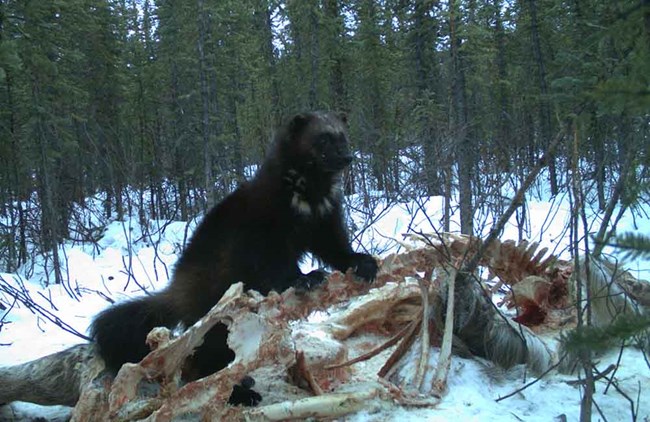Last updated: April 27, 2021
Article
Dominance dynamics among scavengers

For carnivores living in harsh environments with limited food, scavenging can play a key role in their survival. Because top carnivores, such as wolves, kill large prey that smaller species cannot, top carnivores have been said to “subsidize” smaller species by creating scavenging opportunities. We used trail cameras to investigate the scavenging patterns of four species in the harsh wintertime environment of Denali National Park and Preserve: wolves, wolverines, coyotes, and red foxes. Contrary to a “subsidizing” framework, we found that wolves and wolverines dominated scavenging activity on all carcass types, while foxes and coyotes spent much less time scavenging and were more vigilant while at carcass sites, especially in areas heavily used by wolves. This work shows that both large and small carnivores compete for carrion and the larger and more dominant species likely outcompete the smaller.
Gifts of an enemy: Scavenging dynamics in the presence of wolves (Canis lupus)
Abstract
Carrion represents an important resource for carnivores. Examining competition for carrion in a risk–reward framework allows for a better understanding of how predator guilds compete for and benefit from carrion. We used trail camera data to compare wintertime carrion use and vigilance behavior of four carnivores in Denali National Park and Preserve. We found that carrion use was dominated by wolves (Canis lupus) and wolverines (Gulo gulo), followed by red foxes (Vulpes vulpes) and coyotes (Canis latrans). Wolves and wolverines were twice as likely to visit a carcass as foxes and coyotes and their visits were longer and more numerous. Our results suggest scavenging animals reduced their risk exposure primarily by reducing their use of carrion, with some evidence of increased vigilance at busy sites. We found that carrion use and behavior at carcass sites were influenced by the mortality type of the carcass, the age of the carcass, and the long-term intensity of wolf use in the area. Our results also suggest that wolves are the “top scavenger,” and indicate that intraguild competition for carrion strongly affects which species benefit from carrion, with larger and more aggressive species dominating.
Klauder, K. J., B. L. Borg, K. J. Sivy, and L. R. Prugh. 2021. Gifts of an enemy: Scavenging dynamics in the presence of wolves (Canis lupus). Journal of Mammalogy
